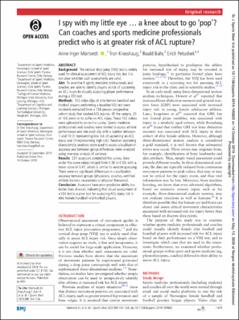| dc.contributor.author | Mørtvedt, Anne Inger | |
| dc.contributor.author | Krosshaug, Tron | |
| dc.contributor.author | Bahr, Roald | |
| dc.contributor.author | Petushek, Erich | |
| dc.date.accessioned | 2020-05-13T10:27:36Z | |
| dc.date.available | 2020-05-13T10:27:36Z | |
| dc.date.created | 2020-01-20T13:55:00Z | |
| dc.date.issued | 2019 | |
| dc.identifier.citation | British Journal of Sports Medicine. 2019, 54(3), 154–158. | en_US |
| dc.identifier.issn | 0306-3674 | |
| dc.identifier.uri | https://hdl.handle.net/11250/2654217 | |
| dc.description | This is an open access article distributed in accordance with the Creative Commons Attribution Non Commercial (CC BY-NC 4.0) license, which permits others to distribute, remix, adapt, build upon this work non-commercially, and license their derivative works on different terms, provided the original work is properly cited, appropriate credit is given, any changes made indicated, and the use is non-commercial. See: http://creativecommons.org/licenses/by-nc/4.0/. | en_US |
| dc.description.abstract | Background: The vertical drop jump (VDJ) test is widely used for clinical assessment of ACL injury risk, but it is not clear whether such assessments are valid. Aim: To examine if sports medicine professionals and coaches are able to identify players at risk of sustaining an ACL injury by visually assessing player performance during a VDJ test. Methods: 102 video clips of elite female handball and football players performing a baseline VDJ test were randomly extracted from a 738-person prospective cohort study that tracked ACL injuries. Of the sample, 20 of 102 went on to suffer an ACL injury. These 102 videos were uploaded to an online survey. Sports medicine professionals and coaches were invited to assess athlete performance and rate each clip with a number between 1 and 10 (1 representing low risk of sustaining an ACL injury and 10 representing high risk). Receiver operating characteristic analyses were used to assess classification accuracy and between-group differences were analysed using one-way analysis of variance. Results: 237 assessors completed the survey. Area under the curve values ranged from 0.36 to 0.60, with a mean score of 0.47, which is similar to random guessing. There were no significant differences in classification accuracy between groups (physicians, coaches, certified athletic trainers, researchers or physical therapists). Conclusion: Assessors have poor predictive ability (no better than chance), indicating that visual assessment of a VDJ test is a poor test for assessing ACL injury risk in elite female handball and football players. | en_US |
| dc.language.iso | eng | en_US |
| dc.subject | cruciate ligament injury | en_US |
| dc.subject | female team handball | en_US |
| dc.subject | football players | en_US |
| dc.subject | video analysis | en_US |
| dc.subject | joint kinematics | en_US |
| dc.subject | elite handball | en_US |
| dc.subject | screening test | en_US |
| dc.subject | anterior | en_US |
| dc.subject | mechanisms | en_US |
| dc.subject | jump | en_US |
| dc.title | I spy with my little eye … a knee about to go ‘pop’? Can coaches and sports medicine professionals predict who is at greater risk of ACL rupture? | en_US |
| dc.type | Peer reviewed | en_US |
| dc.type | Journal article | en_US |
| dc.description.version | publishedVersion | en_US |
| dc.rights.holder | © Author(s) (or their employer(s)) 2020. | en_US |
| dc.source.pagenumber | 154–158 | en_US |
| dc.source.volume | 54 | en_US |
| dc.source.journal | British Journal of Sports Medicine | en_US |
| dc.source.issue | 3 | en_US |
| dc.identifier.doi | 10.1136/bjsports-2019-100602 | |
| dc.identifier.cristin | 1777869 | |
| dc.description.localcode | Seksjon for idrettsmedisinske fag / Department of Sports Medicine | en_US |
| cristin.ispublished | true | |
| cristin.fulltext | original | |
| cristin.qualitycode | 2 | |
